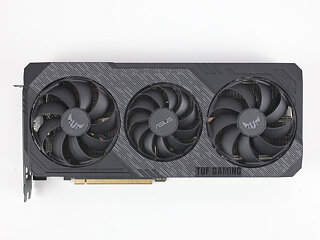 17
17
ASUS Radeon RX 5600 XT TUF EVO Review
Circuit Board Analysis »Packaging
The Card
For their TUF series, ASUS created a new design identity. The card uses black and various shades of gray. Note how the center fan is smaller than the surrounding ones—this is new on the EVO version. A metal backplate in matching colors is included, too.
Dimensions of the card are 28 x 13 cm.
Installation requires three slots in your system.
Display connectivity options include three standard DisplayPort 1.4a and an HDMI 2.0b.
The board uses one 8-pin power connector. This input configuration is specified for up to 225 watts of power draw.
AMD's Navi generation of GPUs no longer supports CrossFire. DirectX 12 does include its own set of multi-GPU capabilities, but implementation requires game developers to put serious development time into a feature only a tiny fraction of their customers might ever use.
Disassembly
As mentioned in the introduction, ASUS had some issues with the initial batch of TUF cards, which caused public outcry from consumers and reviewers. We are testing the fixed version, which has upgraded fans with axial tech to direct the airflow through the fins. Also note how the fan impellers are surrounded by a plastic ring to ensure no air can escape horizontally. The outer fans are 90 mm in diameter, and the center fan is 80 mm across.
The cooling assembly is 100% identical to the one used for the Radeon RX 5700 XT TUF EVO.
Once the cooling assembly is removed, you get access to the heatsink. It uses five heatpipes and a large array of fins to keep the card cool. This heatsink provides cooling for the GPU, memory chips, and VRM circuitry. Do note that the memory chips are cooled by a plate that is bolted to the heatsink—it is not part of it. This means heat transfer is slightly reduced, but still much better than on the original TUF, which just had a thin metal heatspreader on the memory that did not connect with the main heatsink at all.
The backplate is made out of metal to protect the card against damage during installation and handling. There are some thermal pads to pick up a little bit of heat from the other side of the memory chips.
May 4th, 2025 13:39 EDT
change timezone
Latest GPU Drivers
New Forum Posts
- Best USB 3 hub chipsets (16)
- Steam installer asked me if I got Dial Up! (0)
- Are the 8 GB cards worth it? (827)
- Free Games Thread (4660)
- Choosing an Internal HDD (58)
- Technical Issues - TPU Main Site & Forum (2025) (169)
- PSU chirping sound (8)
- The TPU UK Clubhouse (26191)
- type 5 miccro-fit sata cables (3)
- What are you playing? (23543)
Popular Reviews
- Clair Obscur: Expedition 33 Performance Benchmark Review - 33 GPUs Tested
- ASUS ROG Maximus Z890 Hero Review
- ASUS Radeon RX 9070 XT TUF OC Review
- Montech HS02 PRO Review
- NVIDIA GeForce RTX 5060 Ti 8 GB Review - So Many Compromises
- ASUS GeForce RTX 5090 Astral Liquid OC Review - The Most Expensive GPU I've Ever Tested
- Seasonic Vertex GX 850 W Review
- Upcoming Hardware Launches 2025 (Updated Apr 2025)
- ASRock Radeon RX 9070 XT Taichi OC Review - Excellent Cooling
- Team Group GC Pro 2 TB Review
Controversial News Posts
- AMD Radeon RX 9060 XT to Roll Out 8 GB GDDR6 Edition, Despite Rumors (129)
- NVIDIA Sends MSRP Numbers to Partners: GeForce RTX 5060 Ti 8 GB at $379, RTX 5060 Ti 16 GB at $429 (128)
- NVIDIA Launches GeForce RTX 5060 Series, Beginning with RTX 5060 Ti This Week (115)
- Nintendo Confirms That Switch 2 Joy-Cons Will Not Utilize Hall Effect Stick Technology (105)
- NVIDIA PhysX and Flow Made Fully Open-Source (95)
- Sony Increases the PS5 Pricing in EMEA and ANZ by Around 25 Percent (84)
- Parts of NVIDIA GeForce RTX 50 Series GPU PCB Reach Over 100°C: Report (78)
- Intel "Bartlett Lake-S" Gaming CPU is Possible, More Hints Appear for a 12 P-Core SKU (77)
















